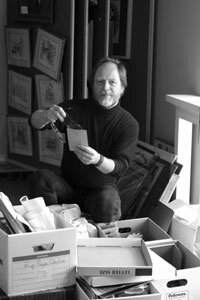ONARCHITECTURE- SIPS and dips: New Arch's coming to Emmet

The new Arch's Frozen Yogurt on Emmet Street, coming in 2008, won't be a typical frozen yogurt shop.
PHOTO COURTESY BRW ARCHITECTS
As mentioned in last week's Dish ["New openings: Do good things come in threes?" December 6], Arch's Frozen Yogurt plans to open a new location on Emmet street next summer. And it appears it won't be an average frozen yogurt shop.
In 2005, Arch's owners bought the old Donut Connection at 1232 Emmet Street. Since then, they've been working with the folks at BRW Architects– known for renovations of Congregation Beth Israel, the Downtown Rec Center, and the Mall side of the Water Street parking garage– to develop a modern two-story building with two outdoor eating balconies, ivy-covered walls, and a host of energy-efficient features.
According to BRW's Mark Humbertson, lead architect for the project, the building will be unique in that part of town for its modern design and sustainable construction, particularly with SIPS roof and wall panels. Structural Insulated Panels (SIPs) are made with polyurethane foam sandwiched between two layers of plywood or fiber-cement, but can also be filled with polystyrene (Styrofoam) or environmentally friendly wheat straw and other organic materials.
As Humberston notes, the factory-manufactured panels will be designed and cut to order, then delivered to the site where they will be fitted together in no more than a few days, a fraction of the time it would take to build a more traditional structure.
Hysterical historians? ‘Tasteless' history blog disappears
City Councilor Kendra Hamilton thought it was a "great idea," and fellow councilor Dave Norris called it a "wonderful new blog."
"I'm adding Hysterical Society to my blogroll," wrote Norris in a November 28 post on his own blog, cvilledave.blogspot.com, "and I applaud its rebellious creator for doing his part to help make Cville history come alive!"
But just 12 days after that rebellious Albemarle Charlottesville Historical Society director, Douglas Day, launched The Hysterical Society, Board members declared it "tasteless" and asked that a link to it on ACHS's website be removed.
"The Society needs more publicity, and a blog may be the way to go," incoming ACHS president Meeks told the Hook ["Historical hysteria: Society brass yank ‘tasteless' blog," November 29], "but frankly, I think this was the wrong approach."
Day complied with the Board's wishes, but he continued to operate the blog as a private citizen, taking an irreverent approach to discussing local history and preservation. However, shortly after the Hook's November 29 story appeared, we noticed the blog had disappeared. It also appears that members of the Historical Society have clammed up.
"I am not at liberty to comment any further on the matter," said the formerly cooperative Day when we asked what happened to the blog.
"I have no comment," said current ACHS president Paul Brockman.
Incoming ACHS president Steven Meeks also declined to comment, despite participating in our previous story.
For inhabitants of the blogosphere, a dead link to a previously lively discussion appears to be cause for mourning.
"I thought it was a cool way to drag in an audience the Historical Society didn't otherwise have," says photographer and local history buff Bill Emory. "I think it's kinda sad they took it down."
"This is a disappointing turn of events," says Norris, "and I hope Mr. Day is able to resuscitate his blog at some point in the near future. I think a little irreverence in the halls of the Historical Society could be a good thing."
Peabody School in the LEED
While a number of builders and developers in town talk about seeking LEED certification for their projects, it appears the Peabody School's new $2.3 million two-story addition, completed last January by Martin Horn Inc. and designed by architect Andy Thomas, is the first to walk the walk.
"We've had inspections for other projects at the school, but none of them were done with the rigor of this site inspection," says Peabody's Head of School Chris Robertson.
Established in 1998 by the U.S. Green Building Council, the Leadership in Energy and Environmental Design (LEED) designation has become the official standard for measuring the quality of environmentally sustainable construction. According to Robertson, the school addition is the first LEED-certified new commercial project in the area. Other projects, such as the Charlottesville Transit Center, are registered as LEED, but have yet to be certified, according to a recent release by Martin Horn Inc.
In addition to a host of environmentally friendly materials such masonry and concrete siding, the 12,000-square-foot new addition has 20 skylights, which work in tandem with the lighting system to conserve energy and provide proper illumination for hallways and classrooms. And as Robertson points out, some LEED points were given for the school initiative to includes its students in the construction process.
"We developed a curriculum at the school that focused on sustainable design," he says. "Our 5th grade students spent five months working with the design-build team, learning about sustainable design as it was being built. It was, and still is, a tremendous learning opportunity for our kids."

Is ACHS director Douglas Day really in hot water for a blog?
FILE PHOTO BY JEN FARIELLO

This new addition at the Peabody School received the area's first LEED certification for a new commercial project.
PHOTO COURTESY MARTIN HORN INC.
#